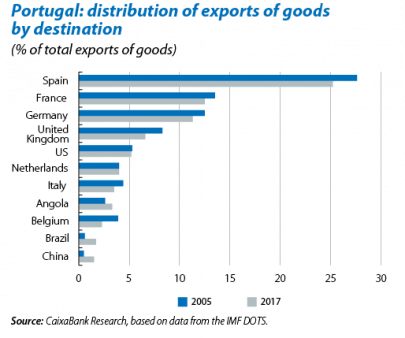Made in Portugal: the new Portuguese export boom
The Portuguese foreign sector has been gaining prominence in recent years. Between 2005 and 2017, exports increased their share of GDP by 16 pps in nominal terms, and now stand at over 40% of GDP. Exports have also played a key role in the recovery of the Portuguese economy. Since 2010, they have been the fastest growing component of demand, with an average growth rate of 6.2% per year. Therefore, it is important to analyse the extent to which exports can continue to act as a driver of growth in the coming years. To this end, an analysis of the destinations behind this growth in trade can provide an initial explanation.
Data on goods trading by country of origin and destination1 show that the positive performance of the Portuguese export sector between 2005 and 2017 has been widespread. They also show that there has been diversification in the destinations to which goods are exported. Portuguese exports of goods to EU countries – its main market – have increased by 46% since 2005 in nominal terms. Furthermore, this growth has been accompanied by greater diversification in the European destinations to which the exports are going. In particular, Portugal has reduced the proportion of its exports going to its main markets (Spain, Germany, France and the United Kingdom)2 and has taken advantage of the eastward enlargement of the EU to export an increasing amount to countries with a high potential for growth, such as Poland and Romania.
Furthermore, the dependence of Portuguese exports on European countries has decreased substantially,3 while markets outside the EU have gained considerable importance, increasing their share of total exports from 19.7% in 2005 to 26.8% in 2017. In fact, exports to non-EU countries have doubled since 2005 and account for much of the growth in exports (around 40% of it). Among these markets, the US is particularly important and remains Portugal’s biggest non-European trading partner – exports to US have grown 57% since 2005. In Angola and Brazil, Portuguese exports have doubled and increased fivefold in the past 12 years, respectively. In both cases, the fact that Portugal has very close ties with these former colonies helps to consolidate the position of Portuguese companies in these markets. Another positive note is China which, in the context of greater bilateral cooperation with Portugal in various areas (such as investment and culture), has become one of its most important trading partners, with Portuguese companies quadrupling their revenues from exports of goods.
Part of the increase in Portugal’s trading volume in recent years can be explained by its greater participation in global production chains. This greater integration into the global economy implies that a portion of the Portuguese products sold abroad represent inputs of products that end up being consumed in other countries. In light of this, we can look at how Portugal’s final foreign demand has changed over time.4 The most recent data from the OECD, from 2011, show that the geographical diversification of Portuguese exports since 2005 is even greater than it was prior to that year. In particular, the final demand from non-EU countries has gone from representing 32% of the total to 41%, in part thanks to the growing demand for Portuguese products in the countries of the ASEAN bloc,5 China and India.
1. Data from the IMF. Exports of goods accounted for 65% of total exports.
2. These countries account for 56% of exports of goods, 6.1 pps less than in 2005.
3. Going from 80.3% of total Portuguese exports of goods in 2005 to 73% in 2017.
4. Measured in terms of domestic added value.
5. Indonesia, Thailand, Brunei, Cambodia, Laos, Malaysia, Myanmar, Philippines, Singapore and Vietnam.




